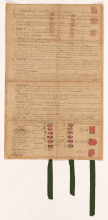National Archives and Records Administration (NARA)
The National Archives was established in 1934 by President Franklin Roosevelt, but its major holdings date back to 1775. They capture the sweep of the past: slave ship manifests and the Emancipation Proclamation; captured German records and the Japanese surrender documents from World War II; journals of polar expeditions and photographs of Dust Bowl farmers; Indian treaties making transitory promises; and a richly bound document bearing the bold signature "Bonaparte"—the Louisiana Purchase Treaty that doubled the territory of the young republic.
NARA keeps only those Federal records that are judged to have continuing value—about 2 to 5 percent of those generated in any given year. By now, they add up to a formidable number, diverse in form as well as in content. There are approximately 13.28 billion pages of textual records; 10 million maps, charts, and architectural and engineering drawings; 44.4 million still photographs, digital images, filmstrips, and graphics; 40 million aerial photographs; 563,000 reels of motion picture film; 992,000 video and sound recordings; and 1,323 terabytes of electronic data. All of these materials are preserved because they are important to the workings of Government, have long-term research worth, or provide information of value to citizens.
https://www.archives.gov/
